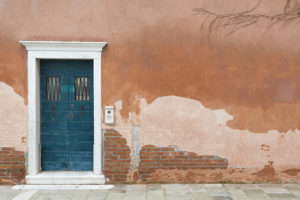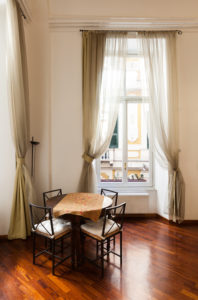How To Romance Your Rooms With Limewash Paint

Limewash paint has been used as a decorative and protective treatment for at least ten thousand years. But thanks to its ecofriendly, antiseptic qualities and magical, romantic finish, it’s just as relevant today. If you’re thinking of bringing home this old-world style, here’s what you need to know.
What Is Limewash, Anyway?

Limewash paint is a mixture of lime and water that, when blended, creates a chemical reaction that generates calcite crystals. These crystals are beautifully reflective, giving limewash a soft glow not found in other finishes.
Originally, limewash wasn’t used decoratively – instead, it was used to protect vulnerable mud structures from the weather. And it’s still just as good at protecting surfaces today, both interior and exterior.
The Benefits of Limewash Paint

Limewash is protective, but it’s also permeable, which lets buildings breathe. This quality keeps water from getting trapped in the walls. Trapped water causes masonry to deteriorate and timber to rot.
This makes limewash a great option for as a paint for brick. It protects brick from the elements; gives it a fresh, new look; and allows the brick and mortar to breathe, so your brick lasts longer.
The variations in tone give the paint its characteristic depth and texture. Because of its ingredients, it’s naturally eco-friendly, too.
Creating a Modern Look With an Ancient Material

Don’t let this paint’s old-world vibe make you think it can’t hang with modern trends. It goes with so many styles, from traditional to cottage to modern. It goes on with a glowing finish that reflects light, so it makes rooms feel expansive, meaning small and dark spaces feel bigger.
Because this goes on much lighter than other finishes, it can be hard to get a dark, saturated color. But many brands now offer a wider range of colors, so talk with a color consultant to know what’s available. Then use this gorgeous finish in spaces where you want to harness that pastel, ethereal glow.
Using This Finish at Home

Limewash is water-based, so it should be used on absorbent materials. Those include:
- Brick
- Concrete
- Masonry
- Plaster
- Wood
Lime’s mild antiseptic properties can also help prevent the spread of disease. Farmers used to whitewash barn stalls with it to keep animals healthy.
Lime can irritate the skin and eyes, so wear protective eyewear and gloves when applying it.
Since it’s a mineral paint, it won’t adhere to other finishes, like latex or oil paint. You’ll need to completely remove old paint with a paint stripper and then wash the walls before you can paint on limewash. This is especially important if you use a solvent to remove the paint. If you don’t rinse it well after removing the paint, the surface could be too acidic, and it may keep the limewash from properly applying.
One important note: You can’t put limewash on with spray or a roller. And you’ll get the best results with a brush that’s stiffer than a regular paintbrush. Apply the first coat like you’re scrubbing it into the wall with circular motions. Use thin coats and wait several days before you add another, especially if it’s cold or humid.
Applying the next coats (use at least three to get the right depth) with vertical strokes gives the limewash its soft, suede-like finish.
Interested in transforming your home with romantic limewash paint? Learn more about our interior house painting services. Or schedule a color consultation to explore paint options and get free 8″ x 8″ color samples today.
